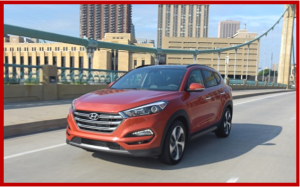The all-new 2016 Hyundai Tucson now in dealerships has a freshened exterior design, two slightly more fuel efficient drivetrains (1 or 5 mpg) and a revised interior that is larger than its predecessor because of a longer overall length, width and wheelbase.
A day of test-driving the crossover on Michigan interstates, secondary and backcountry roads reveals a pleasant 5-seat SUV that is typical of a hot-selling class that seems destined to dominate the market at the expense of cars. One out of three vehicles now sold in the U.S. is a CUV or SUV.
The Tucson carry over powertrain in base trim SE models is competent but unremarkable 2.0-liter, direct-injection four-cylinder with 164 horsepower and 151 lb.-ft. of torque. Matched to it is a six-speed automatic transmission with a manual shifting mode and includes an overdrive lock-up torque converter for higher fuel economy at highway speeds. EPA fuel economy for the FWD model is rated at 23 city, 31 highway, 26 combined. The 26-mpg combined rating is a one-mpg improvement over the previous base engine. It is so-so la-la in performance.
The more competent standard engine in Eco, Sport and Limited models is a new downsized 1.6-liter turbocharged, direct-injection four-cylinder rated at 175 horsepower and 195 lb.-ft. of torque. Peak torque delivery starts at 1,500 rpm and continues to 4,500 rpm. It is responsive and flexible. This so-called Gamma engine has a new water jacket insert that emphasizes cooling in the upper level of the cylinder block where more combustion heat is generated, resulting in lower cylinder head temperatures, which enables leaner air/fuel mixtures that translate to better fuel efficiency.
EPA fuel economy for this powertrain on Eco FWD models is 26 city, 33 highway, 29 combined, a 5-mpg improvement over the former optional Tucson 2.4-liter engine. Sport and Limited FWD turbo engine models are rated at 25 city, 30 highway, 27 combined, a 3-mpg improvement in combined fuel economy over the former Tucson 2.4L engine. It is a reasonable brisk performer with a new 7-speed transmission.
Caveat here: The whole industry is moving at a rapid pace toward small displacement force-fed engines, but the real world fuel economy improvements – if any – are heavily dependent on where you drive and how smooth your driving technique is. In stop and go conditions – whether induced by traffic or by drivers that are first to every red light with late braking will not see any gains in our experience. For these people, the new Tucson’s fuel tank has been increased by 1.1 gallons.
The turbo engine comes with a new, first-in-segment seven-speed dual-clutch transmission. This Hyundai-developed dual-clutch transmission provides decent shifting and good acceleration. Hyundai claims that when compared with some competitors’ continuously-variable transmissions, this DCT is able to handle more torque with minimal power interruption throughout the powertrain operating range for a natural acceleration characteristic that consumers expect and offers greater durability.
 The 2016 Tucson has an optional AWD system from Magna Powertrain. The system includes a driver-selectable AWD lock that allows a differentiated torque split between front and rear wheels, for off-road and extremely slippery road conditions.
The 2016 Tucson has an optional AWD system from Magna Powertrain. The system includes a driver-selectable AWD lock that allows a differentiated torque split between front and rear wheels, for off-road and extremely slippery road conditions.
The system also includes Active Cornering Control, which automatically transfers torque to the wheels with the most traction. The system reduces understeer and enhances cornering performance by braking the inside rear wheel and delivering more torque to the outside rear wheel, providing a torque-vectoring effect. Finally, the system incorporates both Hillstart Assist and Downhill Brake Control to assist drivers facing sharp incline or decline conditions.
Optional safety features include a Lane Departure Warning system, Blind Spot Detection, Rear Cross-traffic Alert, Lane Change Assist, Backup Warning Sensors and Automatic Emergency Braking.

The new Tucson has a standard five-inch color LCD display with rearview camera and touchscreen operation. Apple Siri “Eyes Free” also is available.
The new Tucson has a standard five-inch color LCD display with rearview camera and touchscreen function for intuitive operation. Apple Siri “Eyes Free” integration also is now available. On the navigation-equipped Tucson, popular apps such as Pandora Internet Radio and Yelp are already integrated with the multimedia system. The Yelp app has been optimized for Tucson’s eight-inch touchscreen and will help find restaurants, shopping and more. Once a restaurant is chosen, the navigation system can provide directions to the restaurant without requiring passengers to input the address.


